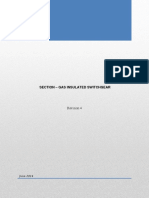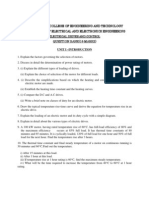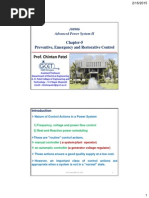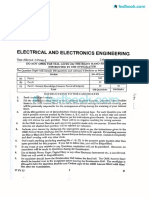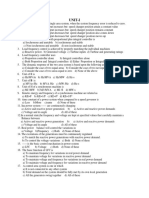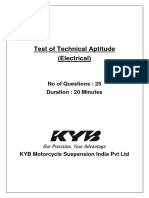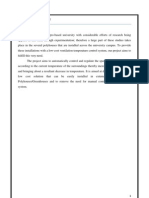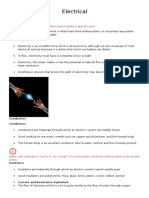Novel Method PMDC Motor Speed Control
Uploaded by
Travis WoodNovel Method PMDC Motor Speed Control
Uploaded by
Travis WoodDC MOTOR SPEED CONTROL
1. Introduction DC motors are increasingly being used Permanent Magnet in a wide spectrum of applications such as domestic equipments, automobiles, information technology equipment, industries, public life appliances.. Direct current (DC) motors comprise one of the most common types of actuator designed into electromechanical systems. They are a very straightforward and inexpensive means of creating motion or forces.
DC MOTOR SPEED CONTROL
DC motors are constructed out of a number of Permanent magnet components. The exact design and materials vary with each type of motor and depend on the application and constraints, but several elements are common to most. The construction generally consists of a stator, which is made up of powerful permanent magnets that generate a static magnetic field; a rotor which carries the armature (also known as the windings or coils) and the commutatator, and rotates in the bearings that support it; and a housing that holds the stator, rotor bearing supports and brushes in a fixed relationship to one another.
DC MOTOR SPEED CONTROL
Figure 1.1: Permanent Magnet Brushed DC Motor Construction, Components and Nomenclature
DC MOTOR SPEED CONTROL
Type speed control : 1-analog speed motor control 2-digital speed motor control
1-ANALOG SPEED MOTOR CONTROL open loop control : Basically, there are three ways to vary the speed of DC motors:
1. With the use of mechanical gears to achieve the desired speed. This method is generally beyond the capability of most hobbyist home workshops.
DC MOTOR SPEED CONTROL
2. Reducing the motor voltage with a series resistor. However this is inefficient (energy wasted in resistor) and reduces torque. The current drawn by the motor increases as the load on the motor increases. More current means a larger voltage drop across the series resistor and therefore less voltage to the motor. The motor now tries to draw even more current, resulting in the motor "stalling".
3. By applying the full supply voltage to the motor in bursts or pulses, eliminating the series dropping effect. This is called pulse width modulation (PWM)
DC MOTOR SPEED CONTROL
in our project we used kit 166 in this kit (PWM) is used Short pulses means the motor runs slowly; longer pulses make the motor run faster. This kit allows controlling the speed of a DC motor in both the forward and reverse direction. The range of control is from fully OFF to fully ON in both directions. HOW IT WORKS (refer to schematic) The circuit can be broken down in four parts: 1. Motor control IC1:A 2. Triangle wave generator IC1:B 3. Voltage comparators IC1:C and D 4. Motor drive Q3-6
DC MOTOR SPEED CONTROL
DC MOTOR SPEED CONTROL
Let us start with the motor drive section, based around MOSFETs Q3-6. Only two of these MOSFETs are on at any one time. When Q3 and Q6 are ON then current flows through the motor and it spins in one direction. When Q4and Q5 are ON the current flow is reversed and the motor spins in the opposite direction .
DC MOTOR SPEED CONTROL
Opamps IC1:C and IC1:D are configured as voltage comparators. The reference voltage that each triggers at is derived from the resistor voltage divider of R6, R7 and R8 . Opamp IC1:B is set up as a triangle wave generator and provides the trigger signal for the voltage comparators. The frequency is approximately the inverse of the time constant of R5 and C1 270Hz for the values used .
The DC offset voltage is controlled by the potentiometer P1 by IC1:A, which is configured as a voltage follower .
DC MOTOR SPEED CONTROL
Closed loop speed control system Even though the steady output speed of the armature-controlled DC motor is proportional to the applied voltage in the open loop, the speed obtained may vary with applied load torques. To achieve better speed regulation, that is to be able to maintain the same speed in the face of fluctuating loads, and to achieve a faster response . There is often the need for a speed controller for small DC motors, so We have investigated the possibility of developing a speed controller that uses the motor as the tachometer. This uses the motor as a generator
DC MOTOR SPEED CONTROL
2-DIGITAL SPEED MOTOR CONTROL The main objectives in this section are to create and calibrate sensors to set the desired speed and measure the actual speed . The project aims at interfacing these sensors with a DC motor. The project also intends to familiarize us with the various control laws of an open as well as a closed loop control system. This is accomplished by interfacing with dc motor as generator tachometer , Op-Amp, DC motor, and use of PWM command. The LCD display is used to read the duty cycles and RPM of the motor resulting from the control action. The keypad is used to input the desired speed and direction .
DC MOTOR SPEED CONTROL
Tachometer Output Measurement of the motors rotational speed is done by uses the motor as tachometer. This uses the motor as a generator - for example small DC permanent magnet motors are often used as DC generators in servo systems - with the generated voltage , the output voltage from the tachometer is (0-7.5). but we are faced with two problem : the first problem is the output voltage from the tachometer is (0-7.5) volt and at this volt the pic will be damage so we transfer this voltage to 5 volt ,and we are make the desired process to deal with this volt as 7.5 volt in the software code
DC MOTOR SPEED CONTROL
The second problem
after the dc motor start rotation the feedback tachometer generate dc voltage from (0 to 7.5) volt and when the dc motor rotate in the other direction the tachometer generate dc voltage from (0 to -7.5) then the volt but if negative voltage appeared on the leg of the pic so to overcome this problem we installed pic will be damaged, and two diods on the input of the pic such that prevent the leg of the pic output current , then the system will be calculate the difference voltage from the output of the tachometer and calculate the and actual voltage difference between the desired voltage .
DC MOTOR SPEED CONTROL
Keypad Interface 4*3 keypad is used for entering information needed to operate the motor controller. The motor speed desired speed , the direction of rotation , and the deadband for on-off control can all be entered from the keypad. LCD Output 2x16 character LCD display is used to output data from the microcontroller. It is run using data in parallel from either 4 or 8 data lines. It requires 6 data lines in this mode to operate, which is a significant portion of the 16 available I/O lines of the microcontroller, in our project we displayed the desired speed and actual speed and the direction of rotation .
DC MOTOR SPEED CONTROL
There are three PID controllers in this design proportional controller , integral controller and derivative controller ,and system will be deal with this parameters as this relation : Start : error= desired Speed actual Speed dt integral= integral +error * derivative= (error Previous Error)/dt output= kp * error + ki * integral + kd * derivative Previous Error=error
You might also like
- Dynamic Analysis of IEEE 14 Bus System: Experiment No: 05No ratings yetDynamic Analysis of IEEE 14 Bus System: Experiment No: 058 pages
- Decoupled Newton Method For Load Flow StudiesNo ratings yetDecoupled Newton Method For Load Flow Studies7 pages
- Medium Voltage IGBT Drives HIVECTOL - HVI - E: Hitachi MV Drives Manufactured in IndiaNo ratings yetMedium Voltage IGBT Drives HIVECTOL - HVI - E: Hitachi MV Drives Manufactured in India8 pages
- Simulation of Some Power System, Control System and Power Electronics Case Studies Using Matlab and PowerWorld SimulatorFrom EverandSimulation of Some Power System, Control System and Power Electronics Case Studies Using Matlab and PowerWorld SimulatorNo ratings yet
- Experiment 4 - EE 308 Flyback ConverterNo ratings yetExperiment 4 - EE 308 Flyback Converter19 pages
- DC Motor Speed Control by Four Quadrant ChopperNo ratings yetDC Motor Speed Control by Four Quadrant Chopper12 pages
- ECE 8830 - Electric Drives: Topic 16: Control of SPM Synchronous Motor DrivesNo ratings yetECE 8830 - Electric Drives: Topic 16: Control of SPM Synchronous Motor Drives59 pages
- Applications of Power Electronics To Power SystemsNo ratings yetApplications of Power Electronics To Power Systems8 pages
- Ch-5 Preventive, Emergency & Restorative Control PDFNo ratings yetCh-5 Preventive, Emergency & Restorative Control PDF35 pages
- DC Machines-Top Interview Questions With Answers - OnlinemcqNo ratings yetDC Machines-Top Interview Questions With Answers - Onlinemcq3 pages
- Power Semiconductor Devices ClassificationNo ratings yetPower Semiconductor Devices Classification9 pages
- Sensorless Control of Permanent Magnet Synchronous Machine Drives - 2023 - Zhu - Front MatterNo ratings yetSensorless Control of Permanent Magnet Synchronous Machine Drives - 2023 - Zhu - Front Matter35 pages
- Developing Counter and Time Delay RoutineNo ratings yetDeveloping Counter and Time Delay Routine24 pages
- ECE 3101 Industrial Electronics: Chopper DrivesNo ratings yetECE 3101 Industrial Electronics: Chopper Drives17 pages
- 3 Transmission Line Modelling and PerformanceNo ratings yet3 Transmission Line Modelling and Performance22 pages
- IOT Based Deliberate Load Shedding Management System: Project Report OnNo ratings yetIOT Based Deliberate Load Shedding Management System: Project Report On34 pages
- TN TRB EEE 2017 Question Paper (English)No ratings yetTN TRB EEE 2017 Question Paper (English)26 pages
- Power System Analysis and Simulation Question Paper100% (1)Power System Analysis and Simulation Question Paper2 pages
- 2.0 Test of Technical Aptitude (Elect) - All - RemovedNo ratings yet2.0 Test of Technical Aptitude (Elect) - All - Removed5 pages
- Directional Over Current Relay: Current Relay (Non-Direction) Will Act For Fault Current in Any DirectionNo ratings yetDirectional Over Current Relay: Current Relay (Non-Direction) Will Act For Fault Current in Any Direction6 pages
- Predictive Maintenance Practices of Induction Motor: V Venkatesh, D Vamsi Krishna, KV Kalyani, D K PandaNo ratings yetPredictive Maintenance Practices of Induction Motor: V Venkatesh, D Vamsi Krishna, KV Kalyani, D K Panda9 pages
- Speed Control of DC Motor Using Pid Controller Based100% (1)Speed Control of DC Motor Using Pid Controller Based16 pages
- Microcontroller Based DC Motor Control: Jayshree Sahu, S.K.Sahu, Jayendra KumarNo ratings yetMicrocontroller Based DC Motor Control: Jayshree Sahu, S.K.Sahu, Jayendra Kumar4 pages
- 3 Sec-III-Hardware Fittings & AccessoriesNo ratings yet3 Sec-III-Hardware Fittings & Accessories49 pages
- Effect of Grading Ring On Voltage Distribution of ArrestorsNo ratings yetEffect of Grading Ring On Voltage Distribution of Arrestors7 pages
- Fretting Fatigue in Overhead ConductorsNo ratings yetFretting Fatigue in Overhead Conductors16 pages
- Anil Agarwal: Research: Mud As A Traditional Building MaterialNo ratings yetAnil Agarwal: Research: Mud As A Traditional Building Material10 pages
- An Introduction To Conway's Games and NumbersNo ratings yetAn Introduction To Conway's Games and Numbers30 pages
- Complete Download Microgrid Architectures, Control and Protection Methods Naser Mahdavi Tabatabaei PDF All Chapters100% (3)Complete Download Microgrid Architectures, Control and Protection Methods Naser Mahdavi Tabatabaei PDF All Chapters65 pages
- Wideband Dipoles - Fan Dipoles: Microstrip AntennasNo ratings yetWideband Dipoles - Fan Dipoles: Microstrip Antennas13 pages
- Isolation Frequency Response: Headphone Measurements: Xiaomi Piston 3No ratings yetIsolation Frequency Response: Headphone Measurements: Xiaomi Piston 31 page
- Rectifier Diodes BYQ28X Series Ultrafast: General Description Quick Reference DataNo ratings yetRectifier Diodes BYQ28X Series Ultrafast: General Description Quick Reference Data6 pages
- EN ACS800 MD El Plan E Screen 3AXD00000273236 FNo ratings yetEN ACS800 MD El Plan E Screen 3AXD00000273236 F42 pages
- Series: Pasted High Technology Lectrolyte Uspension El BatteryNo ratings yetSeries: Pasted High Technology Lectrolyte Uspension El Battery31 pages
- 3-Phase Brushless DC Motor Controller/Driver With Back-Emf SensingNo ratings yet3-Phase Brushless DC Motor Controller/Driver With Back-Emf Sensing12 pages
- Product Advisory Notice: Keeping You Informed of Product ChangesNo ratings yetProduct Advisory Notice: Keeping You Informed of Product Changes5 pages
- WDZ-5211 Line Protection Measurement and Control Device 1 Device Function 2 Protection Function and PrincipleNo ratings yetWDZ-5211 Line Protection Measurement and Control Device 1 Device Function 2 Protection Function and Principle17 pages
- Dynamic Analysis of IEEE 14 Bus System: Experiment No: 05Dynamic Analysis of IEEE 14 Bus System: Experiment No: 05
- Medium Voltage IGBT Drives HIVECTOL - HVI - E: Hitachi MV Drives Manufactured in IndiaMedium Voltage IGBT Drives HIVECTOL - HVI - E: Hitachi MV Drives Manufactured in India
- Simulation of Some Power System, Control System and Power Electronics Case Studies Using Matlab and PowerWorld SimulatorFrom EverandSimulation of Some Power System, Control System and Power Electronics Case Studies Using Matlab and PowerWorld Simulator
- ECE 8830 - Electric Drives: Topic 16: Control of SPM Synchronous Motor DrivesECE 8830 - Electric Drives: Topic 16: Control of SPM Synchronous Motor Drives
- Applications of Power Electronics To Power SystemsApplications of Power Electronics To Power Systems
- Ch-5 Preventive, Emergency & Restorative Control PDFCh-5 Preventive, Emergency & Restorative Control PDF
- DC Machines-Top Interview Questions With Answers - OnlinemcqDC Machines-Top Interview Questions With Answers - Onlinemcq
- Sensorless Control of Permanent Magnet Synchronous Machine Drives - 2023 - Zhu - Front MatterSensorless Control of Permanent Magnet Synchronous Machine Drives - 2023 - Zhu - Front Matter
- IOT Based Deliberate Load Shedding Management System: Project Report OnIOT Based Deliberate Load Shedding Management System: Project Report On
- Power System Analysis and Simulation Question PaperPower System Analysis and Simulation Question Paper
- 2.0 Test of Technical Aptitude (Elect) - All - Removed2.0 Test of Technical Aptitude (Elect) - All - Removed
- Directional Over Current Relay: Current Relay (Non-Direction) Will Act For Fault Current in Any DirectionDirectional Over Current Relay: Current Relay (Non-Direction) Will Act For Fault Current in Any Direction
- Predictive Maintenance Practices of Induction Motor: V Venkatesh, D Vamsi Krishna, KV Kalyani, D K PandaPredictive Maintenance Practices of Induction Motor: V Venkatesh, D Vamsi Krishna, KV Kalyani, D K Panda
- Computer Aided Design of Electrical MachinesFrom EverandComputer Aided Design of Electrical Machines
- Power System Wide-area Stability Analysis and ControlFrom EverandPower System Wide-area Stability Analysis and Control
- Speed Control of DC Motor Using Pid Controller BasedSpeed Control of DC Motor Using Pid Controller Based
- Microcontroller Based DC Motor Control: Jayshree Sahu, S.K.Sahu, Jayendra KumarMicrocontroller Based DC Motor Control: Jayshree Sahu, S.K.Sahu, Jayendra Kumar
- Effect of Grading Ring On Voltage Distribution of ArrestorsEffect of Grading Ring On Voltage Distribution of Arrestors
- Anil Agarwal: Research: Mud As A Traditional Building MaterialAnil Agarwal: Research: Mud As A Traditional Building Material
- Complete Download Microgrid Architectures, Control and Protection Methods Naser Mahdavi Tabatabaei PDF All ChaptersComplete Download Microgrid Architectures, Control and Protection Methods Naser Mahdavi Tabatabaei PDF All Chapters
- Wideband Dipoles - Fan Dipoles: Microstrip AntennasWideband Dipoles - Fan Dipoles: Microstrip Antennas
- Isolation Frequency Response: Headphone Measurements: Xiaomi Piston 3Isolation Frequency Response: Headphone Measurements: Xiaomi Piston 3
- Rectifier Diodes BYQ28X Series Ultrafast: General Description Quick Reference DataRectifier Diodes BYQ28X Series Ultrafast: General Description Quick Reference Data
- Series: Pasted High Technology Lectrolyte Uspension El BatterySeries: Pasted High Technology Lectrolyte Uspension El Battery
- 3-Phase Brushless DC Motor Controller/Driver With Back-Emf Sensing3-Phase Brushless DC Motor Controller/Driver With Back-Emf Sensing
- Product Advisory Notice: Keeping You Informed of Product ChangesProduct Advisory Notice: Keeping You Informed of Product Changes
- WDZ-5211 Line Protection Measurement and Control Device 1 Device Function 2 Protection Function and PrincipleWDZ-5211 Line Protection Measurement and Control Device 1 Device Function 2 Protection Function and Principle

